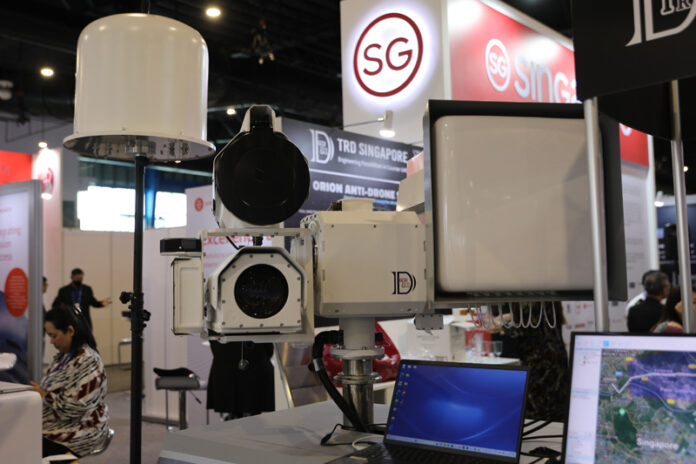
Singaporean company TRD, which specialises in counter-UAS (C-UAS) equipment, unveiled its new Orion-Ship system at IMDEX 2023.
Orion-Ship was developed in response to an undisclosed customer’s requirements. It features an electro-optical/infrared (EO/IR) sensor, and a passive radio frequency detector (a radar can also be added, if desired) with a detection range of 3-10 kilometres.
Also present is a jammer with a 3-5km range. A directional jammer can defeat an approaching UAV, while an omnidirectional jammer provides 360º protection. The system is controlled by an integrated command-and-control (C2) system, which sends alerts and can also be set to operate automatically.
Sam Ong, CEO of TRD Consultancy, outlined three important aspects to fitting the system on vessels. One is finding a suitable place to install it, given that space is often at a premium on decks. Secondly, it must not interfere with existing ship systems, something that Orion-Ship can achieve given that its RF system is passive.
Thirdly, it is primarily designed for commercial UAVs, which operate in specific RF bands. It can operate against certain military-specification UAVs, depending on their frequencies.
Ong said the system can provide a 5-10km bubble around a vessel. This could be expanded even farther by mounting the system on an unmanned surface vessels, for example, which would also give greater mobility.
The Orion-Ship connects to a local C2 system, which in turn plugs into the ship’s C2 network. In this way, the system could also integrate ship sensors such as radars and even weapon systems.
Compared to land-based Orion C-UAS devices, Orion-Ship has also been treated to improve its resistance to sea conditions. Ong noted that it is also ideal for luxury yachts and commercial vessels, as well as law enforcement and naval vessels. Its development was concluded last year, and Orion-Ship has already been fitted on its first vessels.
In other news, last month TRD also opened a purpose-built test facility and range in Thailand. Located on the coast about one hour from Bangkok, customers can test jamming equipment against UAVs.
The test facility includes five radars, multiple RF jammers and even a GPS spoofer. Thailand was chosen since the authorities allow TRD to test UAVs and jammers to a distance of 10km out to sea, something impossible to do in congested Singapore.
TRD opened an office in Thailand a couple of years ago, as the kingdom has proved to be one of TRD’s biggest customers to date.
At IMDEX 2023, TRD also displayed its Orion-H drone gun, of which the latest version is the Mobile Op Console (MOC). The MOC version mounts a smartphone device connected to a central C2 system. When a UAV is detected, the C2 system sends information and compass directions to the operator, so they can accurately target approaching threats.
Ong said that the interest of militaries has spiked since Russia’s invasion of Ukraine, as forces realise their vulnerability against UAVs. Because of this, the importance of the military market is growing quickly. However, militaries tend to have more specific and demanding requirements, plus their procurement processes usually take longer.
TRD has supplied its C-UAS devices to all 11 countries in ASEAN, as well as farther afield.
by Gordon Arthur












